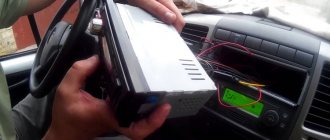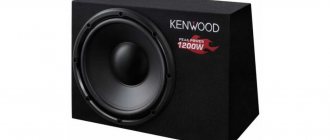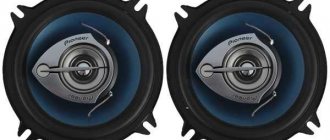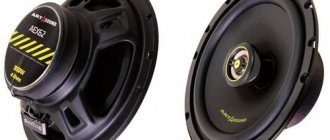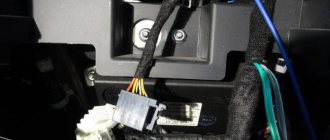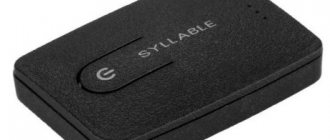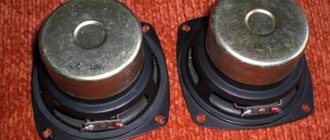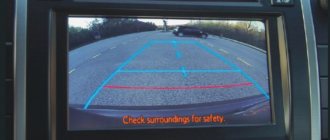Sound quality in a car is one of the most subjective factors. Most car owners are indifferent to the level of acoustics: they play and play. Another part of the drivers, usually young, equate sound quality with volume: if you can hear the windows of neighboring cars rattling, then the sound is good. Well, and the minimum percentage behind the wheel are music lovers who are able to hear the falsity of the fifth violin on the left in a concert recording. Generally speaking, there are more lovers of high-quality car audio among owners of more expensive cars, who are more demanding about every aspect of the car. It is for them that automakers make optional premium acoustics, and all kinds of tuning studios offer options for modifying standard systems. Specialists from the Bloodhound studio showed and told us how to improve the sound in a car.
To begin with, it’s worth explaining what car audio improvement is and how the process of selecting certain components occurs. As manager Ilya Smirnov notes, if the client does not have experience and knowledge in the relevant topic, he can be offered a very wide range of solutions: from standard to exclusive.
Customers often trust specialists to select the equipment that will be installed on their car, because in addition to their experience, they can guarantee the constant availability of high-quality audio components. This is a very relevant point, taking into account the fact that many, and even leading, brands in the car audio industry have rather complex distribution and sales systems in Russia.
In addition, experts know the market situation and can select components from trusted brands, directly from official importers. This is important because most often, unknowing clients are “led” by flashy advertising and big names, not realizing that sometimes a well-known global brand has long ceased to exist and now very dubious products are sold under its guise. Specialists are called upon to protect the client from such mistakes and offer him truly high-quality equipment.
Standard speaker system without casing
An important point in the selection of components is the client’s musical preferences. Before starting to develop a plan for a car, experts make sure to clarify what type of music its owner prefers, as well as at what volume he usually listens to music. Even if you take the highest quality components and set them up perfectly for listening to calm classical music, a lover of electronics or rap is unlikely to appreciate the quality of expensive components, because volume and bass are important to him, which can be completely dispensed with in the case of classical works. Such clients need to focus on completely different technology and even sacrifice the class of equipment for the sake of more power. So the approach to the development of automotive components will be individual, even if we are talking about a standard solution.
Acoustic system after processing. All improvements will be hidden under the skin
This is why standard “music” always seems so discreet and silent: it is created based on the average musical preferences of the buyer, and it is almost impossible to create universal “music” of good quality. In addition, we must not forget that car manufacturers are always limited by such parameters as the weight of the car and the volume of the trunk, so installing, for example, a subwoofer is sometimes simply impossible.
And it will still not be possible to create a truly ideal sound in a car: the location of the components in the limited space of the car will not allow it.
Types of acoustics
To create high-quality sound in the car, three types of acoustic elements are used:
- High-frequency speakers - tweeters. These are small “tweeters” that are capable of reproducing only high frequencies - from 5 to 20 thousand hertz. They are best used in the front part of the car, for example, on the A-pillars. In tweeters, the membrane is rigid because sound vibrations do not travel a long distance from the center of the speaker;
- Coaxial acoustics – also called coaxial. Its peculiarity lies in the fact that such acoustics belong to the category of a universal solution. Such speakers have both high- and low-frequency drivers in one housing. The result is loud, but the quality is noticeably lower if the motorist creates component acoustics;
- Low frequency speakers - subwoofer. Such devices are capable of transmitting sounds with a frequency of 10 to 200 Hz. If you use a separate high- and low-frequency speaker through a crossover, the sound of the composition is much clearer, and the bass does not mix with the high frequencies. For a bass speaker to work, a soft membrane is required and, accordingly, a large size so that it works in swing.
Fans of high-quality car audio are converting broadband acoustics (standard sound that comes with the car from the factory) to component ones. The second option will require an additional crossover.
However, no matter how high-quality the acoustics are, if you do not properly prepare the place for its installation, the sound quality will not differ much from standard loud wideband speakers.
Rules and methods for creating the perfect sound
The equipment is installed in strict accordance with the recommendations given by the manufacturer. Although studying instructions is not typical for Russians, let car audio be an exception to the rule. This rule applies to any equipment, even a car antenna.
If car audio is not installed from scratch, but the capabilities of existing equipment are expanded, then you must be guided by a sense of proportion. It’s very easy to overdo it, but is it worth turning a car into a concert hall? This will probably be redundant.
The correct choice of the type of acoustics is of no small importance for creating an audio system that will best meet the user's requirements. To listen to pop music, it will be enough to install an audio system, which will include a high-quality radio and a set of three speakers. If you want to include bass in the overall car audio, you cannot do without installing a subwoofer and amplifier, which will complement the above-described elements.
When choosing equipment, you should pay attention only to well-known companies whose products are highly respected among specialists. Even if you overpay a little for the brand, you will receive a high-quality product that will last a long time and will not upset you if malfunctions occur.
What does car acoustics consist of?
A car speaker system may include a large number of components that need to be connected correctly in order to enjoy the purity of musical compositions. For many motorists, the acoustics in a car mean a car radio and a couple of speakers.
It's actually just a sound-producing device. Real acoustics require the correct selection of equipment, installation location and compliance with sound insulation requirements. The sound quality of expensive equipment depends on all this.
Here are the key elements that make up effective car audio.
Crossover (pass filter)
As the name suggests, this device is designed to split an audio stream into different frequencies. Externally, the crossover is a box with various electrical parts soldered on a board.
This device is installed between the amplifier and speakers. There are passive and active crossovers. Each of them has its own advantages and disadvantages, and they have different frequency separation effects.
2. Amplifier
This is another device that looks like a box installed between the car radio and the speakers. It is designed to amplify the sound signal. But if a motorist is not a music lover, and he needs a radio to create a general background in the car, then buying an amplifier is a waste of money.
An amplifier makes the sound more powerful, cleaner and better quality. This device is for those for whom not just the music is important, but its purity - so that he can clearly recognize the sound of a vinyl recording.
Before buying an amplifier, you need to correctly calculate its power (it must correspond to the capabilities of the speakers and the size of the car interior). If the car has weak speakers, then installing an amplifier will only lead to a rupture of the diffuser. The power of the amplifier is calculated based on the power of the speakers (or subwoofer). Its maximum should be 10-15 percent less compared to the peak power of the speakers.
In addition to power (the effect of this device will be if this parameter is at least 100 watts), you need to pay attention to the following parameters:
- Frequency range. It should be at least 30-20 thousand Hertz.
- Background level is within 96-98 dB. This indicator minimizes the noise level between tracks.
- Number of channels. Particular attention should be paid to the connection diagram of the acoustics with the subwoofer. It would be nice if the amplifier had a separate channel for it.
3. Subwoofer
This is a speaker that reproduces low frequencies. The key parameter for choosing this component is its power. There are passive (without a built-in amplifier) and active (with an individual built-in amplifier) subwoofers.
In order to fully use the subwoofer so that it does not drown out the work of the other speakers, it is necessary to correctly organize the distribution of sound waves on the front and rear speakers. To do this you can:
- Make an endless screen (the subwoofer is mounted in the rear shelf). In this design, there is no need to make any calculations regarding the dimensions of the box, and the speaker is easy to install. At the same time, the bass quality is at its maximum. The disadvantages of this method include distortion of the subwoofer sound when the car trunk is filled differently. Also, to prevent damage to the speaker, it is necessary to use a “Sabsonic” filter.
- Install a bass reflex. This is a closed box in which a tunnel is made. This method has more disadvantages than the previous one. So, you need to make the correct calculations on the size of the box and the length of the tunnel. The design also takes up a lot of space in the trunk. But if everything is done correctly, then the sound distortion will be minimal, and the low frequencies will be given maximum effect.
- Install simply closed boxes. The advantage of this design is that it protects the speaker from impacts, as well as ease of installation. This reduces the efficiency of the subwoofer, which is why it is better to buy a more powerful amplifier and subwoofer.
4. Speakers
There are component and coaxial car speakers. In the first case, for the sake of sound quality, you will have to make certain sacrifices - you will need to redo the interior of the car (you need to install not two speakers on the sides of the shelf, but determine a place for several speakers). For example, to install three-way acoustics, you will have to look for space for six speakers. Moreover, they need to be installed correctly so that they do not interfere with each other.
If we talk about broadband speakers, then it is enough to install them on the rear shelf near the glass. There is no place for full-size component acoustics there, because, firstly, they should not reproduce low frequencies. Secondly, it must create surround sound, which cannot be achieved when reflected from glass (the sound will be directional).
High pass filter
Next we find the HPF (High-passFilter) item. This is a high-pass filter that cuts the frequency of the sound supplied to the speakers below their specified limit value. This is done because it is very difficult for standard speakers (13–16 cm) to reproduce low frequencies due to their small diaphragm diameter and low power. As a result, the sound is reproduced with distortion even at low volumes. By cutting the low frequencies, you can get clear sound over a larger volume range.
If you do not have a subwoofer, we recommend installing an HPF filter at a frequency of 50 or 63 Hz.
You can then exit the menu using the return button and check the result. It is better to do this at a volume of 30.
If the sound quality is not satisfactory, or if you are outdoors and want to have a loud disco, you can raise the lower limit from 80–120 Hz or more. It is recommended to use the same level of boundary cut if you have a subwoofer. These measures will allow you to increase the purity and volume of the reproduced sound.
There is also an adjustment for the frequency attenuation rate. On Pioneer it comes in two positions - 12 and 24 dB per octave. We advise you to set this indicator to 24 dB.
Door damping
Since the shape of a car door is uneven, sound waves are reflected from it in their own way. In some compositions this is critical, as the music may be mixed with the reflected sound waves. For this reason, you should properly prepare the place for installing the speakers.
To eliminate this effect, quality car audio installers recommend using soft material that will absorb vibrations, preventing them from spreading inside the door. However, given the different structure of its surface, either a soft or hard substrate should be used. If you lightly knock on the door, where the sound will be duller, you should stick a soft damping material. In other places it is hard.
This procedure is very important, since the door in the car is always hollow, so it works like a resonator in a guitar. Only in the case of car acoustics this does more harm to the beauty of the sound than it makes the music more enjoyable.
But even in the case of sound insulation, one should not be overzealous. If you install completely sound-absorbing panels, the music will be muffled, which will immediately become noticeable for a music lover. Let's look at how to make a high-quality sound-reflecting screen.
Door vibration suppression circuit
To determine which part of the doors needs a damper screen installed, you need to knock on the outside of the doors. In those places where the sound will be louder and more distinct, you need to stick on hard noise insulation. Where the sound is duller, stick on soft noise insulation.
But soundproofing the steel part of the door will still not completely eliminate the resonance effect during speaker operation. If the inside of the door resonates, the music will not be heard clearly. It will appear that the speaker is installed in a large speaker.
But on the other hand, you should not overdo it with the installation of sound-absorbing elements. Excessive sound absorption is also fraught with poor sounding acoustics. Some sound waves will lose volume.
The sound screen should consist of two parts (in addition to soundproofing the doors). One part (a sheet of approximately 30*40 centimeters) must be glued immediately behind the speaker, and the other - at the maximum distance from it. As an acoustic damper, it is better to choose a material that does not absorb moisture, because water can get into it from under a worn glass seal.
Car stereo
In order for our acoustics to play properly, we need a good radio for our car. How to choose this device?
Choosing a quality radio comes down to several steps.
Brand selection
It is better to choose a well-known brand. Today, the most popular radio manufacturers are: Alpine, Pioneer, Sony, Kenwood and JVC, which are recognized as leaders in the production of electronics and speaker systems.
Car radios are:
- CD/MP3;
- DVD with and without monitor;
- digital radios;
- multimedia centers and radios with the ability to connect various devices (video players, phones and other gadgets);
Today, most often on the market you can see radios with GPS navigation, USB input, built-in FM receiver or TV tuner, Bluetooth, audio and video player, etc.
Therefore, it depends only on you which radio you buy and what functions it will perform. Many radios are also equipped with a control panel. This necessary little detail will make it possible to control the car radio while the car is moving, not only for those who are in the immediate vicinity of it, but also from the back seat.
Selecting sound quality
The more bands in the equalizer, the better the sound. If you buy a budget radio, you will also need a power amplifier, which can only be connected to it through a special linear output. The price of radios varies greatly depending on the number of “lines”.
Radio panel color
If it matches the backlighting of the keys and the console of your car, it will look very nice. Therefore, when choosing a radio, it is best to be guided by the color of the instrument panel. But since progress does not stand still, a large number of radio tape recorders with changeable backlight modes are being produced, so lately it has become increasingly easier to choose the right color tape recorder. In addition, LED car lighting will help highlight the radio.
It is recommended to entrust the installation of the purchased radio to a specialist from the installation center, or to independently study the wiring and connection diagram in detail. Everyone should know from school the dangers of incorrectly connecting electrical appliances to the network. In the case of connecting a tape recorder, the principle remains the same.
Acoustic screen in the door
The screen is most needed for speakers with high and mid frequencies. The main purpose of using the screen is to provide the clearest and at the same time deep bass. The optimal playback range for such a speaker should be at least 50Hz.
There are two options for acoustic screens:
- Internal - the material is installed under the door card;
- External - a special box is made in which the loudspeaker is located. It is attached on top of the door card.
Each option has its own advantages and disadvantages.
Internal acoustic screen
Pros:
- There is no need to damage the door card, which preserves the interior of the car;
- All elements of the internal screen are hidden under the casing, so there is no need to perform any decorative work for the speakers to not only sound beautiful, but also look decent;
- A powerful speaker will be held more securely, which will allow it to be “swinged” more strongly.
Minuses:
- The speaker will look like a standard speaker. If the emphasis is not only on the beauty of the music, but also on external changes, then it is worth using an external screen;
- The bass won't be as bouncy;
- In such a screen, the loudspeaker will be installed in only one position. Often standard equipment directs the sound wave from the speaker to the feet. This screen option will not allow you to change the tilt angle of the column.
Price issue
Now about the cost. In principle, you can greatly improve the sound with half measures. For example, by installing a good head instead of a standard one. Or installing an amplifier. Yes, even gluing doors or local vibration insulation will improve the sound of even standard acoustics. It all depends on the budget.
I spent about 48,000 rubles on upgrading the sound in my car. I must say I got a good level of sound. This is not top, but it is far from budget level. I would say intermediate-advanced level. Not for competitions, but for the ear.
My car now plays much better than what was standard, approximately at the level of those systems that are installed in an inexpensive premium (such as a Mercedes A-Class without an optional music package, a Mazda with Bose acoustics, and so on). The sound could be improved for half the money. And if there are 100 thousand, then it would be possible to do it even better and of higher quality.
External acoustic screen
Pros:
- Since a significant part of the screen is located outside the door card, there are many more ideas for implementing different design solutions than in the previous version;
- Inside the screen, some of the sound waves are absorbed, and the desired sound is reflected, making the sound cleaner and the bass deeper;
- The column can be directed in any direction. Car audio enthusiasts often configure their speakers so that most of the sound waves are directed toward the top of the cabin.
Minuses:
- Since the speaker will be attached to the outside of the screen, the case must be as durable as possible;
- It will take time to create the design, as well as money to purchase additional material;
- If you don’t have the skills to install speakers, you can not only ruin the sound, but also break the speaker itself (in addition to the fact that it itself vibrates when the sound is loud, the vibrations intensify while driving, which is why the membrane can quickly tear);
- A certain angle of inclination is required.
Sound emission angle
If the speaker is placed too high, it will affect the clarity of the music. High frequencies will be transmitted worse. Experience shows that tilt angles greater than 60 degrees distort the transmission of the audio signal. For this reason, when creating an external screen, this value should be accurately calculated.
When making the outer structure, you first need to securely fasten the inner screen. Then the outer box is either initially made with the desired slope to the vertical, or screwed obliquely with self-tapping screws. The voids are filled with putty. The entire structure is processed with fiberglass and covered with appropriate fabric.
Connection process
The rear speakers are connected to the radio using a miniJack connector. If you have high-quality soldering skills, you can unsolder a suitable connector, which will facilitate the connection process.
If you connect one speaker, you can use the linear output, which is available in most radio tape recorders (minijack). When connecting more speakers, you need to buy splitters or, depending on the radio model (active or passive), connect directly to the connectors on the rear panel.
If the car radio does not have a built-in amplifier (most devices are equipped with a standard amplifier that can provide normal operation to conventional full-range speakers), then in order to drive the bass speakers, you need to purchase an additional amplifier and crossover.
Let's briefly consider the entire process of installing car speakers.
Preparatory stage
First, you need to lay out all the wiring correctly. It is better to combine this process with interior renovation. This way, the wires will not need to be laid in unsuitable areas of the cabin. If the wire connection is poorly insulated, it may come into contact with the car body and cause either leakage current or a short circuit.
When installing speakers in a door, it is necessary to correctly calculate their location in the door frame so that when the door is closed, the speaker housing is not pressed against the post. The wires between the moving elements are stretched so that when the door is closed they do not fray or get pinched.
Insulation Features
For high-quality insulation, do not use twists and tape. It is much more practical to use soldering or mounting strips (this ensures maximum contact between the wires). To prevent bare wires from contacting each other or the machine body, it is necessary to use casings. These are thin insulating hoses. They are put on the wires to be connected and, using high temperature (a match or lighter), are tightly seated at the junction.
This insulation method prevents moisture from penetrating the connection point (prevents the wires from oxidizing), as if it were inside factory insulation. For greater confidence, you can wrap electrical tape over the cambric.
We lay the wiring
It is better to lay the wires along the interior under the upholstery or in a special tunnel, to which there is access if the line needs to be repaired. To prevent the wires from chafing, rubber seals must be installed in the places passing through the drilled holes.
Wire marking
This is an important step that makes it easier to properly connect the wires. Especially if the car owner uses a cable of the same color. To avoid connection errors and ease of repair (or search for these errors), it is practical to use wires of different colors (one color per contact).
Connecting the speakers
If broadband speakers are used, then each of them is connected to the corresponding contact in the radio chip. To make this easier, the car radio manufacturer includes short installation instructions in the kit. It indicates the purpose of each contact.
Each speaker must not only connect correctly, but also have its own place in the cabin. All speakers have their own purpose and operating principle, which affects the quality of the music.
Final work
Before completing the work and hiding the wires under the casing or in the tunnel, it is necessary to test the system. The quality of editing is checked by playing various types of compositions (each of them has its own sound frequencies). You can also check whether the sides are mixed up by changing the balance level in the radio settings.
Installation procedure
First of all, you need to lay the power cables from the battery into the interior. Once you have selected and purchased your conductors, run the negative and positive wires. For this purpose, many cars have a special hole in the shield that separates the engine from the passenger compartment.
When laying wires through a metal hole, you need to protect them from chafing with a piece of rubber or plastic tube. Otherwise, a short circuit may occur.
The positive conductor must be connected through a fuse, the current strength of which must be the same as that on the amplifier's fuse. This fuse link should be located close to the battery (about 30 cm).
Installing tweeters
High-frequency tweeter speakers are installed on the windshield pillars
Before installing “tweeters” in the car (as they are popularly called), remove the lining of the windshield pillars. High-frequency speakers are the basis of sound. They need to be positioned at eye level of the passenger and driver, facing the middle of the windshield. In this position, they will emit sound onto the glass, from which it will be reflected into the cabin.
The left beeper will reflect the sound to the right passenger, and the right one will reflect the sound to the driver.
Laying and connecting wires
The next step is to carefully lay out the rest of the wiring, which includes the wires between the blocks, power wires and acoustic wires. It is not recommended to lay different types of wiring next to each other, or together with the car’s wires.
The intersection of wires of different groups is allowed only at 90 degrees.
Before connecting the speakers in the car, strip the ends of the wires from insulation. Next, connect the wires to the subwoofer and power amplifier. If the sub is purchased in a body, then for a sedan body it is recommended to turn it towards the back of the rear seats. For station wagons and hatchbacks - towards the trunk door. You can make the subwoofer housing yourself, but this will be discussed in a separate article.
How to position the speakers correctly?
The sound quality of acoustics directly depends on how firmly the speakers are secured. For this reason, the acoustic screen is made of wood. In the standard version, the beauty of sound begins to be felt when the weight of the entire structure is more than 7 kg. But to achieve maximum effect, an increase in the mass of the structure is welcome. The main thing is that the door hinges can withstand such weight.
When the screens are connected, there should be no gaps between them. Otherwise, the vibration of the speaker will separate the elements or they will start to rattle. An external screen cannot be installed without an internal one. The reason for this is that the music will not differ from the sound of conventional speakers.
As for self-tapping screws, they must be made of non-ferrous metal. Otherwise, they will be magnetized and distort the operation of the speaker.
Factors affecting sound clarity
The sound quality is influenced by many subjective and objective factors:
- insufficient audio file playback power;
- low-quality standard audio systems and simple acoustics;
- poor car sound insulation;
- malfunction of the electrical equipment of the machine, and as a result, the presence of interference that distorts the sound;
- additional external noise, etc.
Many causes of interference are beyond the driver's control. But it is quite obvious that without the use of high-quality acoustics, it is practically impossible to overcome noise and achieve crystal clear sound in the vehicle interior.
The best car audio
Here is a small TOP of the best car audio at an affordable price:
| Model: | Specifics: | Price: |
| Focal Auditor RSE-165 | Coaxial acoustics; tweeter inverted in a dome; protective steel grille | $56 |
| Hertz K 165 Uno | Speaker diameter – 16.5 cm; component modification (two-way audio separation); power (nominal) 75W. | 60 dollars |
| Pioneer TS-A1600C | Component two-way; diameter of woofers – 16.5 cm; power (nominal) 80W. | $85 |
Of course, there is no limit to either the size or volume of car acoustics. There are craftsmen who, with the help of a couple of additional batteries, a powerful amplifier and huge speakers, can easily organize a rock concert in their Lada, which can cause the windows to fly out. In this review, we looked at recommendations for those who like beautiful, but not prohibitively loud sound.
Here is a short video comparison of coaxial and component acoustics for cars:
COMPONENT or COAXIAL? Which acoustics to choose!


